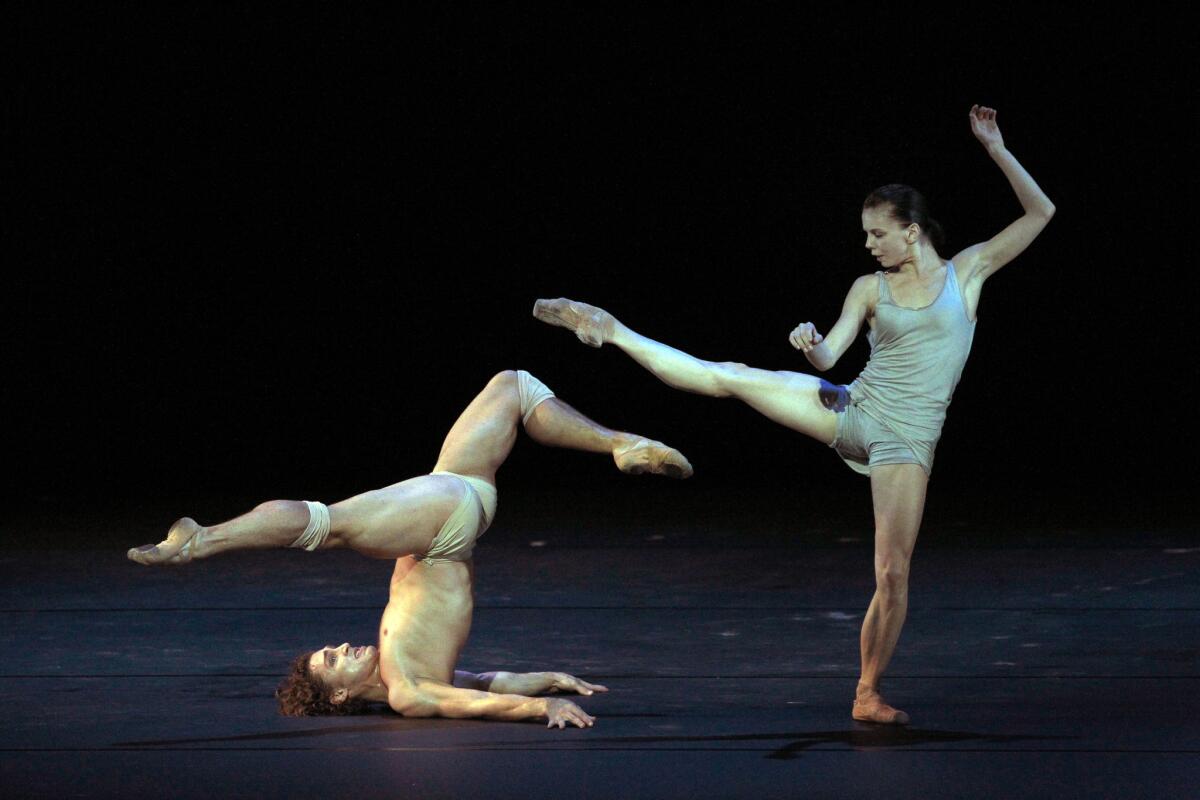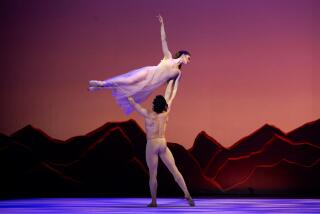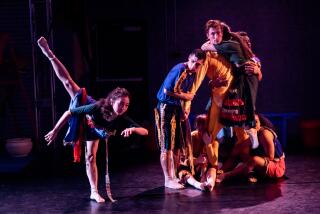Review: Natalia Osipova and Ivan Vasiliev make magic in ‘Solo for Two’

- Share via
The charisma, virtuosity and classical supremacy of Russian ballet dancers Natalia Osipova and Ivan Vasiliev make them genuine superstars, artists who cause the heart to skip.
Before we knew them individually, we experienced them as partners, and theirs is a pairing unique in ballet today. Their partnership was the inspiration for the latest Segerstrom Center for the Arts-Ardani Artists original co-production, “Solo For Two,” which premiered Friday in Costa Mesa, where we saw them first frolicking four years ago as Kitri and Basilio in the Bolshoi’s “Don Quixote.”
There is a template for these premiere events, which have included several “Kings of the Dance” iterations and commissions for Diana Vishneva: put elite classical dancers in a studio with contemporary choreographers of their choosing, stir for a few weeks, and put what develops onstage with first-class theatrical values. Despite all the high-level work, a truly good match between dance-maker and artist is still frustratingly elusive to execute.
“Solo For Two,” remarkably, had magic. “Solo’s” choreographers, Sidi Larbi Cherkaoui, Ohad Naharin, and Arthur Pita, didn’t generate any masterworks. But this time, the process and the exceptional commitment of Osipova, in particular, generated a memorable transformation.
Osipova, a woman-child of pixy face, pliant body and physical exuberance, opened her inner self to us, with a vulnerability that felt intimate, new. Like a writer reading from her journal, Osipova brought innermost feelings to all her dancing, but especially in Naharin’s “Passo.” Was it an illusion? Only she can answer, but it didn’t feel like one.
Cherkaoui’s “Mercy,” was a metaphoric journey from violence—a jerky, robotic, mimed beating—to forgiveness. Cherkaoui’s musical selections outlined his intentions; there were Baroque songs by Johann Schein and Heinrich Schütz (exquisitely performed by conductor Françoise Lasserre, Los Angeles Concert of Viols and soloists) and the Hindustani raga bageshri (sung by Arun Dravid), a song of compassion and anticipated love.
If you didn’t know these works, it was harder to interpret “Mercy’s” full intent. After the shocking opening, Vasiliev had a solo of flowing rolls and floor-accented jumps. Ospiova returned, now assured, to kick him around with her toe shoes. The power play continued and he controlled her with his hand. They concluded as if in a truce, their bodies stretched in a line, one head indistinguishable from the other.
Naharin stripped away artifice in “Passo.” To recordings by Autechre and of British folk music, the movement contrasted raw explosions—from standing to split leaps—with playful jigs and body clapping. The work’s meaning was less significant than how it stretched the duo and illuminated their personalities.
As the evening began with mock violence so it ended, with Osipova getting her revenge by “murdering” Vasiliev. “Facada” by Arthur Pita, whose work is unfamiliar here, was a jokey, mini-melodrama of an angry bride left at the altar. Gay Storm effectively played a dark angel (cynical mother?) with her knowing looks to the audience, while onstage musician Frank Moon played delectable Portuguese fado. But it was Osipova, yet again, who was stellar in a foot whomping folk dance on Vasiliev’s grave.
We’re ready for more of this singular ballerina, no matter what she wants to do.
More to Read
The biggest entertainment stories
Get our big stories about Hollywood, film, television, music, arts, culture and more right in your inbox as soon as they publish.
You may occasionally receive promotional content from the Los Angeles Times.









